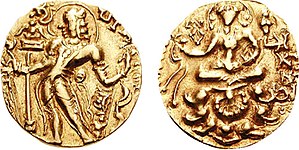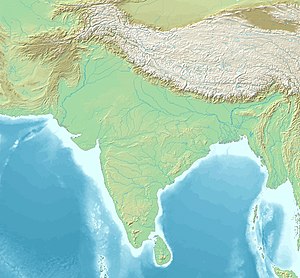| Skandagupta | |
|---|---|
| Vikramaditya Kramaditya | |
 Gold coin of Skandagupta, depicting himself on the obverse, Lakshmi on the reverse. The name | |
| Gupta emperor | |
| Reign | c. 455 – c. 467 CE |
| Predecessor | Kumaragupta I |
| Successor | Purugupta |
| Died | 467 CE |
| Dynasty | Gupta |
| Father | Kumaragupta I |
| Religion | Hinduism[1] |
Find spots of inscriptions of Skandagupta, and contemporary polities.
Skandagupta (Gupta script: ![]()
![]()
![]()
![]() Ska-nda-gu-pta,[2] r. c. 455-467) was a Gupta Emperor of India. His Bhitari pillar inscription suggests that he restored the Gupta power by defeating his enemies, who may have been rebels or foreign invaders. He repulsed an invasion by the Indo-Hephthalites (known as Hunas in India), probably the Kidarites. He seems to have maintained control of his inherited territory, and is generally considered the last of the great Gupta Emperors. The Gupta genealogy after him is unclear, but he was most probably succeeded by Purugupta, who appears to have been his younger half-brother.
Ska-nda-gu-pta,[2] r. c. 455-467) was a Gupta Emperor of India. His Bhitari pillar inscription suggests that he restored the Gupta power by defeating his enemies, who may have been rebels or foreign invaders. He repulsed an invasion by the Indo-Hephthalites (known as Hunas in India), probably the Kidarites. He seems to have maintained control of his inherited territory, and is generally considered the last of the great Gupta Emperors. The Gupta genealogy after him is unclear, but he was most probably succeeded by Purugupta, who appears to have been his younger half-brother.
- ^ "For the temporary reprieve from the Huns won by Skandagupta was the final phase of Indian classicism . The king himself worshipped Hindu gods and goddesses, then returning to the fore, but he did not neglect other beliefs such as Jainism and Buddhism." in Cotterell, Arthur (30 June 2011). The Pimlico Dictionary Of Classical Civilizations. Random House. p. 367. ISBN 978-1-4464-6672-8. and Cotterell, Arthur (1998). From Aristotle to Zoroaster: An A to Z Companion to the Classical World. Free Press. p. 173. ISBN 978-0-684-85596-7.
- ^ Allen, John (1914). Catalogue of the coins of the Gupta dynasties. p. 114.
